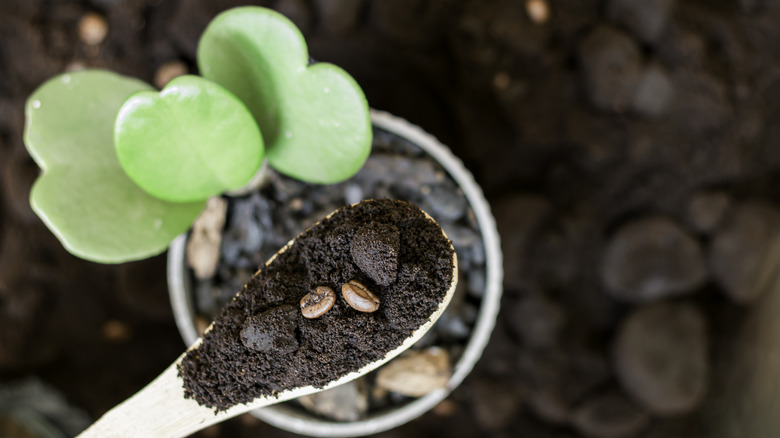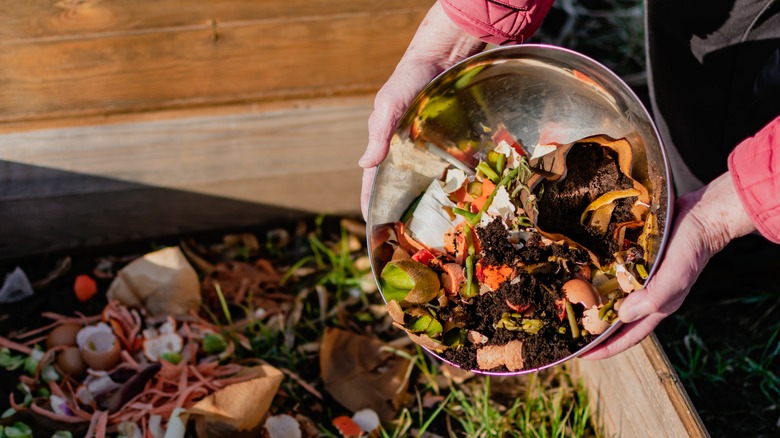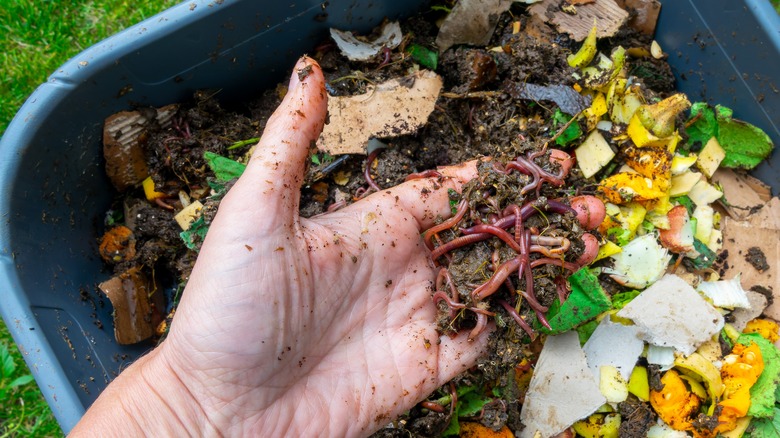Don't Skip This Important Step When Using Coffee Grounds To Fertilize Your Plants
There are dozens of unexpected uses for coffee grounds around the home, from deodorizing shoes to repairing scratches in wooden furniture. Perhaps one of the most popular home coffee hacks is applying leftover coffee grounds to your garden beds as a free, upcycled, and easily available fertilizer that can also be used as a natural pest control. But many sources across the internet fail to report certain rookie mistakes to avoid when considering coffee grounds as a garden supplement. One critical step can improve the efficacy of coffee grounds in your garden: composting.
It's not uncommon for people to suggest applying coffee grounds directly to the soil in your garden, but doing so could have a number of unintended consequences for your plants. Too much coffee in one garden bed could destroy the soil's nutrient balance and deter plant growth through excessive caffeine. "Like anything else, coffee grounds can be overdone," cautions Oregon State University soil scientist Linda Brewer. Composting your coffee grounds with other materials allows for the right ratio of coffee grounds to soil and increases the availability of nutrients for your plants.
Why compost your coffee grounds?
Coffee grounds offer 1 to 2 percent nitrogen not otherwise available to plants, but placing grounds directly onto your garden's soil will do little to improve nutrient availability for your plants. The nitrogen in coffee grounds is more likely to be tied up by microorganisms feeding on it in the soil than to benefit your plants. Due to the low availability of nitrogen from coffee grounds alone, soil scientist Linda Brewer recommends mixing grass clippings or manure into the grounds if applied directly to the soil. But this method adds extra ingredients and steps to the soil amendment process that could be streamlined by using coffee not as a standalone soil supplement, but a "green" (nitrogen-rich) component of a larger, balanced compost system. In other words, coffee is more effective as a fertilizer when it makes up 25 percent or less of compost than when it's applied directly to a garden bed.
Coffee grounds are often recommended as a standalone layer for mulching, but we'd caution against this method of direct application, too: If added in too thick of a layer, coffee grounds can compact and dry out, making water less available to the soil below. Since it takes little more than a 1/2-inch layer of coffee grounds to disrupt the process of water/nutrient absorption in the soil, mulching with your leftover grounds can be riskier than incorporating them into a balanced compost pile instead.
The best ways to supplement compost with coffee
As mentioned above, coffee grounds can be incorporated into your compost in the same way you'd add other "green," nitrogen-rich materials, such as leaves, flowers, and grass clippings, or food scraps. Balance your greens with the carbon-rich "browns" of composting, i.e. newspaper, dry leaves, and pine needles. To avoid affecting the pH of your compost, be sure to use brewed coffee grounds only (not dry grounds): While coffee is acidic prior to brewing, the leftover, brewed grounds have a pH of about 6.5, making them pH neutral.
If you have a vermicompost system — otherwise known as a worm bin — coffee grounds can add an extra benefit to your compost by sustaining your worms. According to the Missouri Botanical Garden, the red wiggler worms commonly used for composting "have gizzards that need grit to grind up food. Soil, shredded leaves, and coffee grounds are examples of things that support their digestive process." As always, it is helpful to keep balance in mind when composting coffee grounds in this manner; while it wouldn't be sufficient to feed your compost worms only coffee grounds, they can be a helpful ingredient in your worm bin in moderation.


